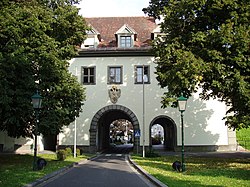Fürstenfeld
You can help expand this article with text translated from the corresponding article in German. (May 2010) Click [show] for important translation instructions.
|
Fürstenfeld | |
|---|---|
 Graz Gate, part of former town fortifications | |
| Coordinates: 47°03′00″N 16°05′00″E / 47.05000°N 16.08333°E | |
| Country | Austria |
| State | Styria |
| District | Hartberg-Fürstenfeld |
| Government | |
| • Mayor | Franz Jost (ÖVP) |
| Area | |
| • Total | 50.31 km2 (19.42 sq mi) |
| Elevation | 276 m (906 ft) |
| Population (2018-01-01)[2] | |
| • Total | 8,549 |
| • Density | 170/km2 (440/sq mi) |
| Time zone | UTC+1 (CET) |
| • Summer (DST) | UTC+2 (CEST) |
| Postal code | 8280 |
| Area code | +43 3382 |
| Vehicle registration | HF |
| Website | www.fuerstenfeld.at |
Fürstenfeld (Austrian German: [ˈfʏrstn̩fɛld]; Hungarian: Fölöstöm) is a small historic city in Styria, Austria. It is situated near the border with Hungary, which is why the city was originally founded. The town has become quite famous in Austria and Germany because of the song by the same name by Styrian band S.T.S..
Fürstenfeld has a population of some 8,902 as of January 1st 2024. It was the centre of an eponymous district until the end of 2012, when it was merged with Hartberg to form the district of Hartberg-Fürstenfeld.
Fürstenfeld was founded around 1170 as a defense against the Hungarians (the present Austrian state of Burgenland was part of Hungary until after World War I, so Fürstenfeld used to lie right on the border) and received its town charter in 1215. Today it is known for its schools, middle-sized industry, and vicinity to several spa towns (Bad Blumau, Bad Loipersdorf and Bad Waltersdorf in Styria, and Stegersbach in Burgenland).
Geography
[edit]Fürstenfeld is located in the lower Feistritz valley near the Burgenland border. Elevation of the urban area ranges from 255m to approximately 300 m ü. A. The city`s central part sits on a river terrace two dozen meters above the valley floor.
History
[edit]This section needs expansion. You can help by adding to it. (June 2021) |
First human traces in the Fürstenfeld area are attributed to the Neolithic age. There are numerous Urnfield culture archaeological finds and the Romans also found their way into the later Province of Noricum bordering their Pannonia province. From the 6th century on, Slavs diffused into the Pannonic region and were followed by Bavarian settlers in the 8th century.
Twin towns — sister cities
[edit]Fürstenfeld is twinned with:[3]
 Aindling, Germany
Aindling, Germany Körmend, Hungary
Körmend, Hungary Vişeu de Sus, Romania
Vişeu de Sus, Romania Zug, Switzerland
Zug, Switzerland
Notable people
[edit]- Anita
- Herbert Depisch
- Wilfried Elmenreich, researcher and university professor
- Hans Fronius
- Sissy Handler
- Richard L. Heschl, born in Welsdorf
- Markus Hirtler (alias Ermi-Oma), cabaret artist
- Max J. Hiti
- Max Keimel
- Karl Mader, painter, graphic artist
- Bert Isatitsch
- Katharina Paldauf (1625-1675) "flower witch" prosecuted during the Great Witch trial of Feldbach
- Josef Reichl (1913, Rudersdorf - 2003)[4]
- Helmut Röhrling (known as "Schiffkowitz"), member of S.T.S.
- Emmerich Schreiner
- Hanna Schulze-Bauer
- Hannes Schulze-Bauer
- Günter Timischl (born 1948, Fürstenfeld), member of S.T.S.
- Fritz Vogt
- Gregor von Rezzori, studied in Fürstenfeld
References
[edit]- ^ "Dauersiedlungsraum der Gemeinden Politischen Bezirke und Bundesländer - Gebietsstand 1.1.2018". Statistics Austria. Retrieved 10 March 2019.
- ^ "Einwohnerzahl 1.1.2018 nach Gemeinden mit Status, Gebietsstand 1.1.2018". Statistics Austria. Retrieved 9 March 2019.
- ^ "Fürstenfelder Partnerstädte" (in German). Fürstenfeld. Archived from the original on 2022-12-17. Retrieved 2023-01-12.
- ^ Parlamentarische Materialien: Erklärung des Präsidenten Gottfried Jaud anlässlich des 50. Jahrestages der Gründung des Europarates. Stenografisches Protokoll der 654 Sitzung /Seite 42, http://www.parlament.gv.at/pd/steno/PG/DE/BR/BRSITZ/BRSITZ_00654/SEITE_0042.html?P_PM=SEITE_0042 Archived 2007-09-26 at the Wayback Machine
External links
[edit]- Official website of Fürstenfeld (in German, English, and Hungarian)


